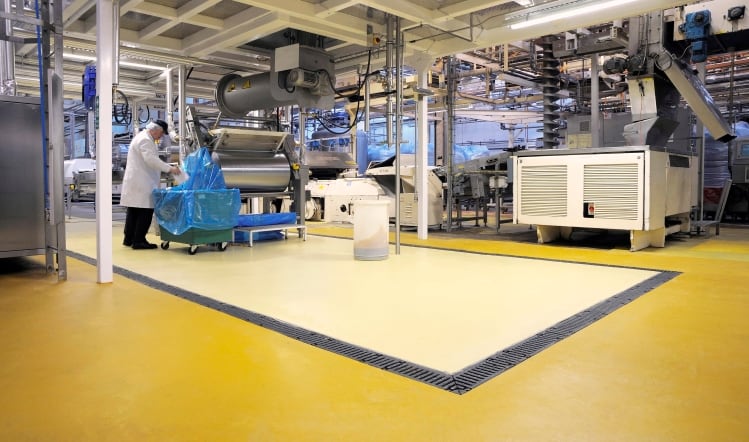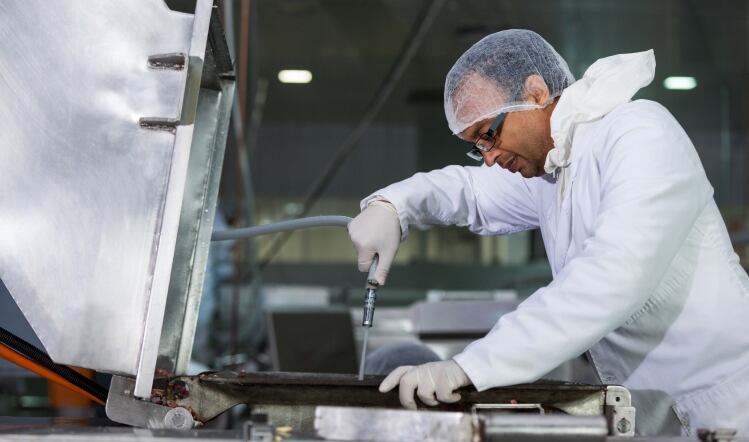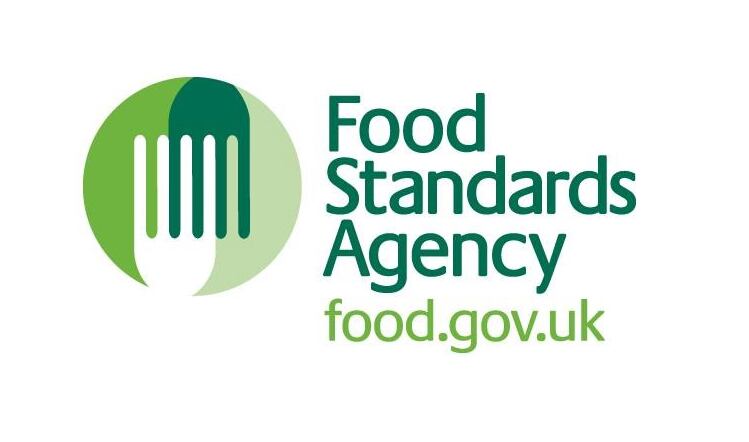Whether it’s designing a new factory floor or upgrading an existing space, the same time-honoured considerations of health and safety, hygiene, and energy efficiency are all crucial to a project’s success.
But with much of the focus often centred on the equipment layout, it can be easy to overlook the importance of some of the less glamorous aspects of design – such as floors and doors – in meeting those needs.
Hygiene is a major selling point for Flowcrete Group, a manufacturer of seamless resin floor, wall and coving, as well as other specialist coating technologies. Its Hazard Analysis and Critical Control Points-certified Flowfresh range of ultra-hygienic, high-performance floors offers an average lifespan of 15 years, claims the company, outperforming cheaper floors over the longer term.
The company stresses the importance of robust flooring to ensure plants run reliably, and so that unprofitable downtime or health and safety issues are avoided.
Grant Adamson, technical director at Flowcrete, has devised a “lifecycle cost considerations” model, taking into account the capital outlay, maintenance and replacement costs associated with factory flooring.
Cheaper flooring will often require greater maintenance and result in costly downtime, Adamson says. It could also potentially lead to a foodborne illness outbreak if contaminants build up in gaps and cracks, he adds.
‘Improve health and safety’
“With Flowfresh, anti-bacterial additives can be built into the flooring, as can slip resistance to improve health and safety,” Adamson claims.
The Pladis-owned McVitie’s plant in Glasgow uses Flowfresh RT in bright yellow across the main thoroughfares of a busy production line (pictured), providing a sanitary, slip-resistant surface, while the Flowfresh MF system creates smoother flooring for cleaning directly under the line.
Flowcrete can also create bespoke flooring, taking into consideration specific on-site challenges – from corrosive sugary production lines to the low temperature requirements of fresh fish storage or the movement of cattle. Surfaces are tailored to withstand specific impacts, chemicals, substances, temperatures, workload or weights, it says.
While good floors are especially important from a hygiene point of view, investing in high-speed industrial doors can generate significant energy and efficiency savings.
The large doors typically used at loading bays tend to perform badly from an energy efficiency point of view, suggests Nick Cox, area sales manager for Sara Loading Bay Specialists (LBS).
The company has introduced a secondary door innovation, the Sprint Spiral, made from aluminium panels backed with an expanded-foam insulating layer that prevents heat transfer through the door itself, while acting as a solid barrier against drafts and air currents.
It significantly reduces heat loss, according to Sara LBS, and has generated payback on investment in only 18 months for a number of warehouse managers.
Significant energy savings
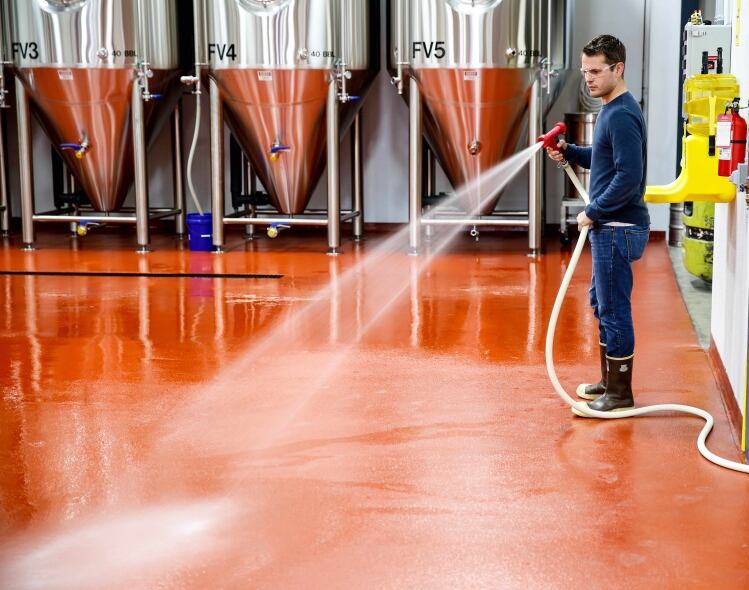
For another supplier, Kenfield Doors, energy savings that coldstores can achieve from the installation of secondary doors are significant.
It makes little sense to spend money on an efficient refrigeration system only for cold air to be lost through open doors, says Kenfield managing director Tom Moloney. By installing secondary doors, outer doors can still be left open to allow workers and vehicles to move in and out of the food storage area.
“Some of our customers have reported savings in the region of 20–25%,” says Moloney, who recommends light, PVC-covered secondary doors that staff “can easily brush through”.
Secondary doors allow the coldstore temperature to be maintained, preventing the ‘snowing’ effect caused by a build-up of warm air in a cold room, which can lead to icing on the floor – a safety hazard.
They also avoid the trip hazard of propped-open doors, avoid tangling with trolleys of foodstuffs and offer the hygiene benefit of being wipe-clean.
“For the installer, the system designer and the architect, secondary doors should be a must on their checklist when they are planning a new system, updating an existing plant or looking to improve efficiencies,” Moloney says.
Boosting efficiency is central to any ambitious business, and part of that process includes having a sophisticated cleaning and maintenance regime, to alleviate any health and safety problems further down the line.
Fleet Safety Award
Lorien Engineering Solutions works with food and drink manufacturers to optimise health and safety on-site. Earlier this year, it was awarded a gold and silver Fleet Safety Award from the Royal Society for the Prevention of Accidents, and is one of only three organisations to have received a second Patron’s Award for occupational health and safety from the organisation.
“All companies want to improve profitability through efficiency,” says Gordon Elkin, architectural consultant at Lorien. “This means ease of cleaning and maintenance and reducing risk to products and the business as a whole.
“The quality and reliability of all our clients’ products is fundamental in maintaining and enhancing their reputation with customers and, therefore, at the forefront of all projects.”
There’s also a desire to protect and improve the environment as part of a robust corporate social responsibility strategy, Elkin argues. “Companies can now embrace the latest technology for efficiency and energy consumption including, for example, insulation materials,” he says. “Other measures include LED lighting, building management systems, and reuse of process water.”
Recently, Lorien helped Britvic install new polyethylene terephthalate bottling lines at its Leeds and Rugby manufacturing sites. As well as optimising operational efficiencies, the investment was aimed at minimising the impact of its operations on the environment in line with Britvic’s sustainable business programme, A Healthier Everyday. As part of Britvic’s multi-discipline project team, Lorien supported it with project management, compliance, and design services.
“We explore the use of new and improved materials and construction techniques if appropriate, but will not compromise good design,” says Elkin. “More broadly, we help customers achieve the highest standards of hygiene and noise reduction in design and construction.”
Design goes digital
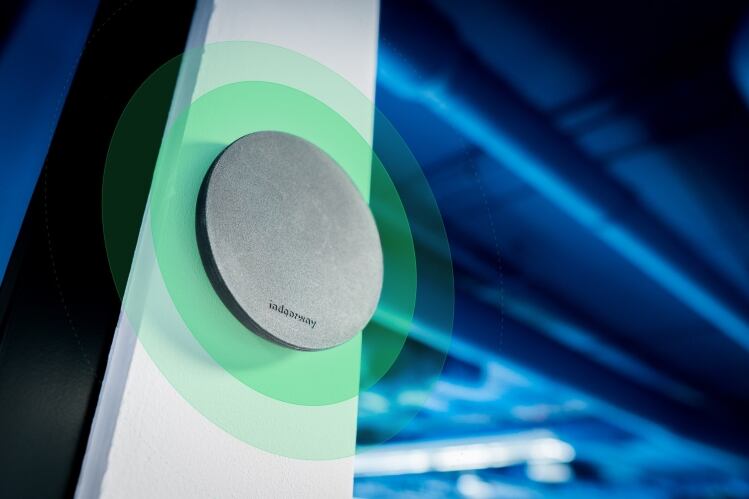
Food and drink manufacturers are increasingly turning to digital technology in their quest to optimise plant design, improve maintenance programmes and streamline production.
“When designing a new factory space, the key objective is to create a layout that ensures increased productivity and efficiency,” says Phil Brown, managing director of Fortress Technology Europe, which can offer an expert hand in integrating its digital metal detection kit into both new and existing factory spaces.
“During the design process, it is essential that the longer-term risks – including potential wastage – is correctly assessed early on in the process. If, for example, metal detection equipment is pushed to the end of the line, any contamination will be caught at the most expensive part of the production process.”
Some companies go so far as to offer dedicated plant design and factory layout software to give manufacturers a clear overview and control of the design process.
Through its MPDS4 software, CAD Schroer says designers can “holistically and intelligently” design the process plant. As well as extensive 3D design and visualisation capabilities, the modular suite includes applications for project management and quality control.
Pipe runs must be designed with future-proofing and safety in mind, advises the company. The same principle applies to the design of cable trays, air conditioning systems and the supporting structural steelwork, it adds.
Smart building company Indoorway, meanwhile, recently launched InSites 4.0, a set of digital tools it says firms can use to modernise buildings, increase revenue streams and introduce leaner management.
InSites 4.0 allows companies to take a “closer and smarter” look inside their plants, analyse typical movement patterns, and introduce improvements and innovations to the work-cycles of factories, warehouses or logistics hubs, Indoorway says.
These could potentially reduce maintenance costs by up to 20%, improve time-efficiency by as much as 15%, and reduce the risk of accidents, the company adds.

